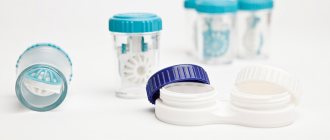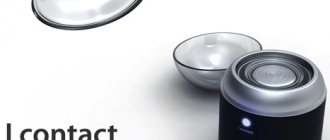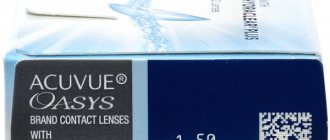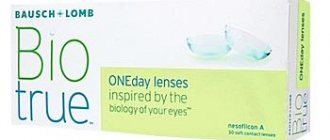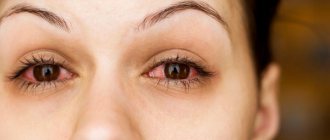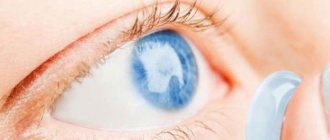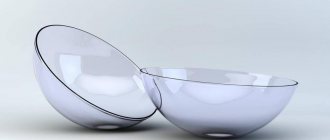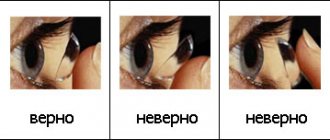HomeArticlesArticles about lensesHow to care for contact lensesSolutions for contact lenses: how to choose and which is the best
Published:
Back to archive
Why store contact lenses in solution? This question is often asked by patients who are purchasing contact lenses for the first time and do not want to create unnecessary inconvenience for themselves.
Experienced contact lens users have encountered cases where the contact lens remained exposed to air. The contact lens dried out quickly, became brittle and hard, and tended to break at the slightest touch. Only the presence of water in a contact lens makes it soft and imperceptible to the eye. There is a certain pattern: the more water that can be introduced into the composition of a contact lens, the better its tolerability.
Is there anything I can use to replace contact lens solution?
Why, then, can’t you use tap water, which is quite sufficient in every home?
Press reviews indicate that even in the most prosperous and wealthy countries, some contact lens users do just that, saving money on special solutions and... often resulting in very serious complications. Microorganisms contained in tap water, when released from a contact lens into the eye, can cause ulcerative inflammation of the cornea and even loss of the eye. Not to mention the fact that the composition of tears and ordinary water is significantly different, which causes pain in the eyes.
Can I use sterile saline solution?
In the past, this was almost the only way to care for contact lenses. The lenses were stored in a 0.9% salt solution and occasionally boiled in a saucepan. Some people still use this method now. What are its shortcomings? When wearing a contact lens, two negative phenomena inevitably occur: on the one hand, the lens accumulates contaminants from tear fluid and the environment, on the other hand, it is constantly contaminated with various microorganisms (bacteria, fungi, etc.). Only daily removal of contaminants and destruction of germs guarantee safe wearing of contact lenses.
What it is?
Lens solution is a special liquid that is intended for the care of contact lenses. Most of the products that are on sale are intended for soft contact lenses; there are also special formulations that are universal.
After you remove your lenses, you will need to place them in a special liquid. If this is not done, then they can quickly dry out in the air. To prevent your products from drying out, you will need to use special liquids. In addition to dirt, various bacteria can be located on the lenses and they can be eliminated using a special liquid.
Opening a contact lens case
It is important to know! It is necessary to store lenses in a special liquid, and ordinary water is not suitable for this.
By using a variety of lenses you can ensure maximum comfort as they:
- Similar in composition to human tears.
- Lubricates the eye and provides easy glide.
- Clean products from protein deposits.
Introduction
As the contact lens industry continues to innovate and introduce new contact lens materials, this article will once again highlight the importance of caring for your replacement lenses.
We will focus primarily on multifunctional solutions (MFRs) and look at what is needed for contact lens care products to effectively provide high biocidal activity and be biocompatible. Of course, nowadays one of the main directions of market development is the increase in prescriptions of daily soft contact lenses [1], however, it would not be amiss to cite data from the annual report of the British Association of Contact Lens Manufacturers (ACLM), according to which Approximately 51% of UK lens wearers still use lens care products (whether they wear routine replacement lenses, rigid lenses or traditional contact lenses), and the majority of this group wear lenses with either a monthly or two-week replacement period [2 ]. According to a report from the Euromcontact agency, the UK and Ireland rank third in the number of prescriptions of silicone hydrogel contact lenses for elective replacement, following Norway and Sweden [1]. Also a review by Morgan et al. demonstrated that the majority of patients (92%) are still prescribed MPR for elective lens care [3].
Multifunctional solutions have complex chemical formulas, consist of a number of substances, their purpose is to effectively disinfect and clean the contact lens, and they must be compatible with the tissues of the eye. The solution is subject to requirements not only regarding how it works and whether it is safe, but also regarding the degree of difficulty of its use from the consumer's point of view. In addition, this solution must maintain its properties until the expiration date indicated on the packaging and be compatible with a wide range of materials used to manufacture contact lenses. Therefore, over the decades, manufacturers have been updating the chemical formulas of MFRs, this was especially pronounced with the growing popularity of silicone hydrogel CLs. Their constituent components, including buffers, surfactants, and chelating agents, optimize the physical properties of solutions to match tear composition and maintain homeostasis, which can improve biocompatibility with the ocular surface [4]. In table 1 summarizes all the components of modern MFRs. Before discussing why these particular components are used, let's look at some of the physiological aspects of the tear film.
Table 1 Components of modern multifunctional solutions [1 ]
| Component | Action | Substances used |
| Buffer | Maintains the desired pH value, which affects comfort and antimicrobial activity | Borates, phosphates, citrates |
| Osmolar agent | Supports Osmolarity | Sodium chloride |
| Chelating agent | A substance that binds with metals and can improve antimicrobial activity | Ethylenediaminetetraacetic acid (EDTA) |
| Surface-active substance | Cleans the CL surface and improves wettability | Poloxamers, poloxamine |
| Moisturizing agent | Enhances wettability, thereby providing comfort, reducing surface tension | Poloxamine, glycols, glycerin, polysaccharides, copolymers, hydroxypropyl methylcellulose |
| Antimicrobial agent | Reduces the number of microorganisms during disinfection and prevents them from multiplying in the solution container | Polyhexamethylene biguanide (PHMB), polyquaternium-1, myristamidopropyldimethylamine (Aldox), alexidine, hydrogen peroxide |
| Protein elimination agents | Removes denatured protein from the surface of the lens and maintains the level of proteins in tears | Hydranates, sulfobetaine |
Composition of solutions
Today you can find a huge variety of products on the market. They may differ not only in their composition, but also in their features. During the purchase, you must study the composition that is presented on each solution.
Maxima solution
In the photo you can see that the composition will contain:
- Buffer substance.
- Sodium chloride.
- Chelating agents.
- Surfactants.
- Conditioners that are intended to lubricate the eyes.
The composition of each lens solution will further determine its properties. To make wearing lenses comfortable in the future, you will need to contact an ophthalmologist so that he can select a truly high-quality composition.
How solutions are tested
The US Food and Drug Administration (FDA) is one of the world's leading agencies testing contact lens solutions before they are introduced to the market. In Europe, the supervision of medical products is carried out by the European Commission (EC) [14]. Contact lens solutions are considered medical supplies. It is important to remember that in the European Union and the United States such products are divided into three groups: with low, medium and high health risks [14].
Contact lenses worn during the day are considered a medium risk product with respect to patient safety, and according to the FDA classification are called Class II medical products, the same is true for solutions for the care of contact lenses [14]. And the EU classifies them as class IIb medical products. In this article, we will review the FDA 510(k) and ISO/DIS 14729 procedures used to test the antimicrobial effectiveness of solutions. Using five specific strains of microorganisms from the American Type Culture Collection (ATCC), tests are performed under precisely controlled and reproducible conditions. The tests have two levels: the main one (the so-called stand-alone) and the secondary one (a test as part of the system, an additional stage is required to pass this level). ISO/FDA standards require that, in stand-elon mode, a solution demonstrates a three-log reduction in bacterial populations (i.e., 1000-fold, or 99.9%), and a one-log reduction in fungal populations (i.e., 10 times, or 90.0%). In table Figure 2 shows the model for both levels of testing and the microorganisms used for it.
Table 2 Model for testing contact lens solutions
| Microorganisms from ATCC | Stand-elon | As part of the system |
| Bacteria: Pseudomonas aeruginosa, Staphylococcus aureus, Serratia marcescens | Population decline by three logarithmic units (99.9%) | The sum of the average log reduction for three bacterial species is at least five log units, with a minimum average reduction of one log unit for each bacterial species |
| Fungi: Candida albicans, Fusarium solani | Population reduction by one log unit (90.0%) |
It is clear that ISO/FDA standards must be consistent for testing all solutions. That is, all solutions must pass the same tests. However, there are opinions that these, although strictly defined, tests should be expanded to include other strains.
Some manufacturing companies use the same model as the ISO/FDA and provide additional evidence that their solution demonstrates the desired effectiveness in "real world" conditions with microorganisms such as methicillin-resistant Staphylococcus aureus and Acanthamoeba. The importance of this was highlighted more recently when studies were carried out to test the hypothesis that there was an increase in the incidence of Acanthamoeba keratitis (AK), caused by Acanthamoeba, in the UK between 2012 and 2014. Research results showed that AKs were observed three times more often in the period 2010–2011 than in 2004–2009. The following were identified as risk factors for AK: disinfection with Oxipol solution (this MPP is no longer sold), poor lens care, poor hand hygiene, wearing contact lenses when swimming or bathing, wearing FDA Group IV contact lenses (high levels of moisture, ionic) and belonging to certain socio-ethnic groups [15].
Recent reports indicate that the FDA is exploring options to include testing for Acanthamoeba in mandated tests, such as testing the in vitro potency of a “used” solution after its preservative content has been reduced. They also consider new analytical methods for classifying solutions according to preservatives and surfactants [4]. Other developments are centered around the need to correctly classify the group of silicone hydrogel CL materials when testing solutions. Traditional classification divides contact lens materials into four groups depending on the degree of moisture content and surface electrical charge (ionic and non-ionic). With this information, practitioners can select the most appropriate materials for patients based on preservative absorption and deposit formation [16]. And this is beneficial for the manufacturers themselves because they do not need to test their product on each specific material; it is enough to select one that represents the entire group [16].
Since silicone hydrogels are not included in any of the four groups, a new model was proposed, according to which a fifth group is created with subgroups based on moisture content, surface electrical charge, the presence or absence of special surface treatment, hydrophobicity or hydrophilicity of the monomer. Such a system should make it easier to test lens-solution interactions and it is hoped that it will help predict potentially harmful interactions [16].
Types of lens solutions
According to their functions, all lens solutions can be divided into:
- Saline. This product is considered most similar to human tears.
- Disinfectants. Similar products are created on the basis of hydrogen peroxide. It is this substance that provides high-quality disinfection.
- Cleansing. Usually these are special enzyme tablets that will rid your lenses of protein deposits.
- Multifunctional. These are the most popular products that are widely used.
Solution for hard contact lenses
Hard contact lenses are quite rare, but they can also be found. Care for them may also differ. They will contain hydrophobic groups and therefore such a solution will have a lower degree of viscosity.
Product for hard contact lenses
To care for gas permeable lenses, you must use special products. They should also be selected by an ophthalmologist.
How to buy solution for contact lenses in the Lens Warehouse online store
To purchase lens solution, make sure the product is suitable for your contact lens type. Carefully read the instructions for use of the solution and use it strictly in accordance with the manufacturer's recommendations.
Buying a solution for cleaning contact lenses through the Lens Warehouse online store is easy and simple.
The Lens Warehouse online store delivers lens care products to Yekaterinburg and the cities of the Sverdlovsk region: V. Pyshma, Berezovsky, Koltsovo, Kompressorny, Nizhny Tagil, Kamensk-Uralsky, Pervouralsk, Sysert. Delivery conditions and how to get free delivery
Back to archive
How to choose a solution
It is not recommended to select the product yourself. The composition of many liquids is considered similar, but their properties can be quite diverse. For hard and soft lenses, your best bet is to use different products. Also, be sure to pay attention to what type of lenses a particular product will be intended for.
Here are the basic recommendations that you also need to follow:
- Hydrogen peroxide-based solutions should not be used for colored lenses.
- For silicone hydrogel products, it is better to choose a composition that contains peroxide.
- If you are planning to choose NoPub products, then remember that they can cause allergies.
- Multi-purpose products are the most convenient to use.
Recommendations for using lens solution
When using a particular solution, you will need to follow the instructions and recommendations indicated on the package:
- The product must only be stored in a closed form.
- Before using the solution, you must wash your hands.
- Keep the liquid bottle clean.
- Change the solution after use.
If necessary, also use enzyme tablets regularly for cleaning. With their help you can get rid of protein deposits.
Review of popular lens solutions
Renu MultiPlus is the most popular solution and is ideal for treating soft lenses. Many doctors prescribe this solution for those with sensitive eyes.
Renu Multiplus – universal lens cleaner
Maxima is an excellent lens cleaner. If you start studying the composition, then you can understand that it will resemble a human tear. The main advantage is considered to be quite low cost.
Maxima Elite
Complete Comfort Plus solution is a multifunctional product that provides effective cleaning. This product will contain substances that will relieve eye irritation.
Complete Revitalens is a lens cleaner
One Step solution does not contain a variety of preservatives that could cause irritation. The set also includes a special container.
One Step is a peroxide solution
Aosept Plus solution is a product manufactured by a well-known company. While using it, you can perform high-quality lens processing. There are no preservatives in the composition and therefore it is perfect for sensitive eyes.
Now you know what lens solutions exist. We hope this information was useful and interesting.
Lycontin and other remedies
Currently, the market offers a huge range of companies that produce solutions for lens care. Let's try to understand all the diversity and determine all the advantages and disadvantages of specific brands.
Likontin
Used on lens models that are intended for long-term wear (up to three months). This solution is more aimed at cleaning the dirt that has accumulated during wear. For complex stains, Licontin F is offered; it is positioned as a means of daily care for any type of lenses.
One Step Peroxide System
Also designed for long-term wear lenses to remove all possible deposits from the surface. It is equipped with a special container in which a plastic disk is installed to neutralize hydrogen peroxide to avoid damage to the lenses. Complete disinfection takes 6 hours.
The only drawback is that only the container included with the drug is suitable for processing, as it is resistant to the components of the solution.
Enzyme cleaner OPTIMED
Powerful deep cleaning solution for lenses. It works by breaking down protein compounds that form during wear, allowing the optical surface to be completely cleaned.
Use in its pure form, like previous brands, is prohibited. The drug is added to the universal solution for lenses. After cleaning, the lenses must be rinsed with a universal solution.
If you use hard and airtight lenses, you should pay attention to the DELTA cleaner. The kit includes a universal solution and a solution for daily care. Together they reduce discomfort and irritation from hard lenses.
Also, each lens manufacturer produces their own care products that best suit their models. This choice will be excellent for people who do not want to experiment and take risks.
